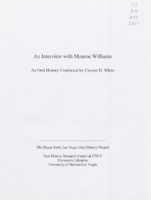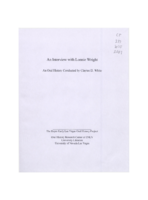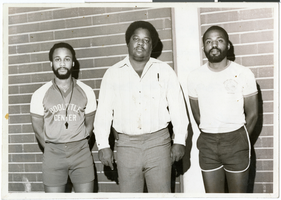Search the Special Collections and Archives Portal
Search Results

Transcript of interview with Monroe Williams by Claytee D. White, August 15, 2000
Date
Archival Collection
Description
Interview with Monroe Williams conducted by Claytee D. White on August 15, 2000. Williams was one of the first black firefighters in 1963, later becoming involved in real estate. He and his wife, Brenda Williams, were community leaders.
Text

Transcript of interview with Paul Pradia by Claytee D. White, July 13, 2010
Date
Archival Collection
Description
Interview with Paul Pradia conducted by Claytee D. White on July 13, 2010. Pradia, who moved to Las Vegas in 1995, teaches golf and is a board member of 1st Tee of Southern Nevada and the Nevada Senior Games, working to promote women golfers. He remains an active member of Omega Psi Phi fraternity.
Text

Transcript of interview with Lonnie G. Wright by Claytee D. White, October 23, 2009
Date
Archival Collection
Description
Interview with Lonnie G. Wright conducted by Claytee D. White on October 23, 2009. Wright played basketball at UNLV and became a successful local educator and businessman. His grandmother worked as a maid for prominent Las Vegans.
Text

Transcript of interview with Roosevelt Toston by Claytee D. White, July 11, 2006
Date
Archival Collection
Description
Interview with Roosevelt Toston conducted by Claytee D. White on July 11, 2006. Toston grew up in Epps, Louisiana, and came to Las Vegas in the 1950s as a teenager. He describes his experience at Las Vegas High School and the first jobs he held at the Fremont Hotel and the Nevada Test Site. Toston honed his skills at Dana McKay's School of Business, Bell Telephone of Nevada, and in the military. A correspondence course in broadcasting led to jobs at television stations 3 and 8, and ultimately to a position with the Convention Authority in the area of tourism marketing.
Text

Lovell Gaines and friends at Doolittle Rec Center: photograph
Date
Archival Collection
Description
Taken at Doolittle Rec Center, includes (L-R) Bobby McRoy, Lovell Gaines and Wendell Williams after a softball game.
Image
Cork Proctor Photograph Collection
Identifier
Abstract
The Cork Proctor Photograph Collection (1960s-1980s) primarily contains black-and-white photographic reproductions of early Las Vegas, Nevada; the Cal-Neva Lodge at Lake Tahoe, Nevada; and various celebrities. The collection also includes black-and-white photographic prints of the Helldorado Parade. Cork Proctor was a comedian who performed throughout Nevada and the United States.
Archival Collection
Michael S. Mack Papers
Identifier
Abstract
The Michael S. Mack papers (approximately 1940s-1950s, undated) consist of photographs and documents related to the early Jewish community of Las Vegas, Nevada. Group photographs depict the Mack family and the Las Vegas Jewish community at events during the 1940s and 1950s, when the Las Vegas Jewish Community Center was the main Jewish organization in town. Individuals in the photographs were identified by Michael Mack. The collection includes documents written by Michael Mack that describe the early Las Vegas Jewish community and the history of his father and uncles, Louis, Nathan, and Harry Mack. The documents also list the names of Jewish individuals and businesses in Las Vegas.
Archival Collection
Lake-Eglington Family Photograph Collection
Identifier
Abstract
The Lake-Eglington Family Photograph Collection contains photographs of the Lake-Eglington Family in and around Las Vegas, Nevada from 1900 to 1976. The materials include photographs of early Las Vegas resident Olive Lake-Eglington and her family shortly after they moved to Las Vegas in 1904, as well as her eventual husband Earle Eglington after he moved to Las Vegas in 1911. The materials also include photographs of Native American artifacts, schools in Clark County, Nevada, artesian wells, the Hoover (Boulder) Dam, the Colorado River, Mt. Charleston, the Mormon Fort, the Stewart (Kiel) Ranch, the Las Vegas Ranch, and many early residents of Las Vegas.
Archival Collection

Micheal Miller interview, April 5, 1976: transcript
Date
Archival Collection
Description
On April 5, 1976, collector Broderick T. Ackerman interviewed Michael Miller who has lived in Nevada since 1910. In this interview, Mister Miller speaks about his time working on ranches and as a trapper in Northern Nevada. He also speaks about his time running nightclubs in Las Vegas, Nevada, as well as seeing much growth throughout his time living in Las Vegas.
Text

Morgan H. Mills interview, March 26, 1981: transcript
Date
Archival Collection
Description
On March 26, 1981, Matthew A. Carr interviewed Morgan Mills (b. July 27, 1914 in Grand Junction, Colorado) about his life in Boulder City, Nevada and his work at the Boulder (Hoover) Dam site. Mills speaks primarily about his time working on the dam as a mechanic with the United States Bureau of Reclamation, as a tourist guide with the Boulder City Tourist Bureau and as a musician in local bands. Moreover, Mills speaks about attending the University of Nevada, Reno and playing music there. Lastly, he talks about the Great Depression, how it affected Las Vegas and Boulder City, the development of different infrastructure and the speakeasies in Boulder City during the Prohibition era.
Text
